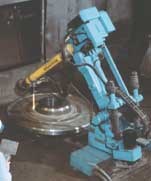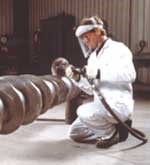The Advantages of Thermal Spray
Thermal spray technology is a cost-effective means to repair worn components and incorrectly machined parts.
Since its beginnings nearly a century ago, plant superintendents and maintenance personnel have relied on thermal spray technology as a cost-effective means to repair worn components and incorrectly machined parts for light and heavy industrial equipment. The manufacturers of thermal spray equipment and materials have continued their efforts to make thermal spray technology more attractive by creating new spray systems and materials. As a result, it is now possible to tailor a coating solution to fit a customer’s needs.
There are four thermal spray processes: flame, arc, plasma and high-velocity oxygen fuel (HVOF).
Thermal Spray Technology
Like overlay welding or chromium plating, thermal spraying is a coating process. The feedstock material, in the form of a wire or powder, is melted or softened by flame or electricity and propelled onto the workpiece. During coating application, the spray torch traverses the workpiece to produce a coating. As with all industrial processes, thermal spraying has its advantages and limitations. Understanding these characteristics is the key to taking advantage of thermal sprayed coatings. Some of the benefits of thermal spray coatings include the following.
- Reduced Cost. The cost of repairing the component is less than buying a new one. Often, the coating actually lasts longer than the original material used.
- Low Heat Input. With few exceptions, the thermal spray process leaves the component’s thermal history alone.
- Versatility. Almost any metal, ceramic or plastic can be thermal sprayed.
- Thickness Range. Depending on the material and spray system, coatings can be sprayed from 0.001 to more than 1 inch thick. The thickness typically ranges from 0.005-0.1 inch.
- Processing Speed. The spray rates range from 3-60 lb/hr depending on the material and the spray system. Typical rates for material application are 1/2 -2 lb of material per sq ft per 0.01 inch thickness.
Flame Spraying
In the flame spraying process, oxygen and a fuel gas, such as acetylene, propane or propylene, are fed into a torch and ignited to create a flame. Either powder or wire is injected into the flame where it melts and is sprayed onto the workpiece. Flame spraying can be readily performed in the shop or onsite and is generally low cost.
Some of the materials that are typically applied are stainless steels, nickel aluminides, Hastelloy alloys, tin and Babbitt metal (a tin-based alloy). With relatively low particle velocities, the flame spray process will provide thicker build-up for a given material of any of the thermal spray processes. The low-particle velocities result in coatings that are more porous and oxidized compared to other thermal spray coatings.
Porosity can be advantageous in areas where oil is used as a lubricant, because a certain amount of oil is always retained within the coating, increasing its life. Oxides in the coating increase hardness and enhance wear resistance. For applications requiring thick buildup and high hardness, self-fluxing alloys are often sprayed and subsequently fused. The fusing process ensures metallurgical bonding to the substrate, high interparticle adhesive strength and low porosity levels.
Flame Spraying Solves the Problem. Compressor cylinders represent a major investment of capital, and, consequently, plants normally have overhaul schedules to ensure that their cylinders run at peak efficiency. The bores of compressor cylinders range from 6-48 inches in diameter and can run from 6-72 inches in length. During an overhaul, the lining of the compressor cylinder is inspected for scars and gouges. These defects can lead to increased friction, loss of oil and reduced operating pressure. When the decision is made to repair the liner, the bore is undercut, sprayed with stainless steel, ground and honed to specification. As mentioned previously, the stainless steel coating possesses the oil retentive properties of cast iron, which leads to a decrease in wear when the compressor is first started.
Arc Spraying
In the arc spray process, two wires are simultaneously brought into contact with each other at the nozzle. The electrical load placed on the wires causes the tips of the wires to melt when they touch. An atomizing gas, such as air or nitrogen, is used to strip the molten material off the wires and to transport it to the workpiece. Arc spraying is reasonably inexpensive and readily useable in the field. Low particle velocities enable high-maximum coating thickness for a given material. Materials typically applied by arc spraying include stainless steels, Hastelloys, nickel aluminides, zinc, aluminum and bronze.
Recent advancements in nozzle and torch configurations provide greater control over coating quality and spray pattern. For example, the wires can be sprayed finely or coarsely. A “fine” spray leads to smooth, very dense coatings, whereas a “coarse” spray enables larger coating thickness. With regard to patterns, an oval-shaped spray may produce a method to coat certain components more efficiently.
Arc Spraying Resolves Roll Repair Dilemma. A classic repair job for a thermal spray job shop is the reconditioning of rolls or cylinders with worn journals. These rolls or cylinders generally range from 1-24 inches in diameter and 5 inches to 20 ft in length. Typically, the rolls or cylinders ride in bearings and over time the journals become worn. The repair procedure involves undercutting the journal to remove the worn material, spraying the section with stainless steel and then finishing it back to its original dimensions. This repair procedure usually costs a fraction of a new roll. Another benefit to the customer is that the coating usually has a higher hardness than the base material. Coupled with the fact that the coating is oil retentive, the coating is capable of increasing the life of the journal by another 20-30%.
Steel Duct Protection. In this application, the customer was looking for a way to prevent the corrosion of steel ducts. The ducts are 6-ft wide x 6-ft high. They are used to transport corrosive gases, including sulfuric acid, which would penetrate through the steel in six months. The solution was to spray a sacrificial layer of aluminum on the interior of the ductwork. In the 15+ years of service, thermal spray crews have only needed to return twice to apply more coating to areas that had become too thin.
Plasma Spraying
Plasma spraying is generally regarded as the most versatile of all the thermal spray processes. During operation, gases such as argon and hydrogen are passed through a torch. An electric arc dissociates and ionizes the gases. Beyond the nozzle, the atomic components recombine, giving off a tremendous amount of heat. In fact, the plasma core temperatures are typically greater than 10,000C, well above the melting temperature of any material. Powder is injected into this flame, melted and accelerated toward the workpiece.
Plasma Spray Extends Component Life. Pumps, about two-ft in diameter, are used to convey baking soda out of a tank. The baking soda had reached the seal section of the impeller and was abrasively wearing grooves into the shaft. The solution was to plasma spray chromium oxide onto the seal section and to finish the section to size. Chromium oxide coatings are characterized by high hardness and a low coefficient of friction. The coating increased the life of the seal setion by 400%.
HVOF
The high velocity oxy-fuel process was invented only 20 years ago, yet has thrust the thermal spray application range into areas that were once unattainable. In HVOF spraying, a combination of process gases, such as hydrogen, oxygen and air, are injected into the combustion chamber of the torch at high pressure and ignited. The resulting gas velocities achieve supersonic speeds. The powder is injected into the flame and also accelerated to supersonic speed. The results are the densest thermal spray coatings available.
The HVOF process is the preferred technique for spraying wear and/or corrosion resistant carbides as well as Hastelloy, Triaballoy and Inconel alloys. The coatings have very high bond strengths, fine as-sprayed surface finishes and low oxide levels.
HVOC for Reconditioning Pumps. Sewage pumps used to move raw waste face corrosion as well as wear issues. In one specific application, pumps were used to move sewage consisting mainly of solids Despite the protection that the chromium plating provided the 4 1/2 inch diameter and 24-48 inch long rotors, they were replaced every 6-12 months. The solution provided by HVOF spraying involved undergrinding the rotors, spraying tungsten carbide and finishing the rotor to size. Currently, the rotors are reconditioned every five or more years, representing a 500% increase in life.
Worn Conveyor Screws. Conveyor screws are used in power plants to transport limestone into the boilers. The customer used a screw manufactured from carbon steel, and it needed to be replaced/repaired yearly due to the abrasion of the limestone. The thermal spray solution was to apply a thin layer of wear-resistant tungsten carbide on the shaft and both sides of the flights using the HVOF system. This repair procedure has extended the life of the screw significantly.
Steel Blowers. The same customer as in the previous description used steel blowers that were three inches in diameter to move the corrosive gases through the ducts. However, the sulfuric acid in the gases caused the steel to corrode and unbalance the blower. The blower needed repair every six months. The solution was to spray a thin layer of Hastelloy C onto the blower. Now the blower is repaired every 24 months, a 300% increase in life.
Outlook
The reconditioning of worn components via the thermal spray process has proven itself as a viable method for saving money by not only reconditioning the component back to original specifications but also in extending part life. By understanding the variety of successful applications, a choice can be made that will save the manufacturer or processor substantial downtime and increased profits that result in an excellent return on investment.
The case histories in this article show that component service life can be increased up to 500%. By reducing premature component failure, thermal sprayed parts can save thousands of dollars. With a variety of application methods and coating selections, thermal sprayed surfaces offer solutions for parts renewal, wear prevention and corrosion resistance.
Related Content
Surface Prep Solution for Rusted Rebar in Concrete
Julie Holmquist of Cortec Corporation discusses passivating corrosion on rebar and other reinforcing metals.
Read MoreCoatings Plant Evolves with Market Trends
Expanding its focus from exclusively serving the RV industry, one of this company’s stand-alone coatings plant has successfully extended its services to additional markets.
Read MoreProducts Finishing Reveals 2024 Qualifying Top Shops
PF reveals the qualifying shops in its annual Top Shops Benchmarking Survey — a program designed to offer shops insights into their overall performance in the industry.
Read MoreCuring Oven Basics
Simply heating up the substrate does not cure the coating. There are many variables to consider when choosing the best cure oven for your application...
Read MoreRead Next
Education Bringing Cleaning to Machining
Debuting new speakers and cleaning technology content during this half-day workshop co-located with IMTS 2024.
Read MoreDelivering Increased Benefits to Greenhouse Films
Baystar's Borstar technology is helping customers deliver better, more reliable production methods to greenhouse agriculture.
Read MoreEpisode 45: An Interview with Chandler Mancuso, MacDermid Envio Solutions
Chandler Mancuso, technical director with MacDermid Envio discusses updating your wastewater treatment system and implementing materials recycling solutions to increase efficiencies, control costs and reduce environmental impact.
Read More

















.jpg;maxWidth=300;quality=90)







